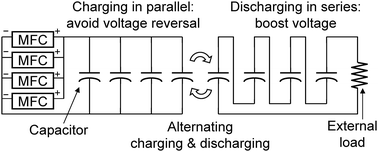Capturing power at higher voltages from arrays of microbial fuel cells without voltage reversal†
Abstract
Voltages produced by microbial

* Corresponding authors
a
Department of Civil and Environmental Engineering, Penn State University, 212 Sackett Building, University Park, PA, U.S.A
E-mail:
blogan@psu.edu
Fax: +814-863-7908
Tel: +814-863-7908
Voltages produced by microbial

 Please wait while we load your content...
Something went wrong. Try again?
Please wait while we load your content...
Something went wrong. Try again?
Y. Kim, M. C. Hatzell, A. J. Hutchinson and B. E. Logan, Energy Environ. Sci., 2011, 4, 4662 DOI: 10.1039/C1EE02451E
To request permission to reproduce material from this article, please go to the Copyright Clearance Center request page.
If you are an author contributing to an RSC publication, you do not need to request permission provided correct acknowledgement is given.
If you are the author of this article, you do not need to request permission to reproduce figures and diagrams provided correct acknowledgement is given. If you want to reproduce the whole article in a third-party publication (excluding your thesis/dissertation for which permission is not required) please go to the Copyright Clearance Center request page.
Read more about how to correctly acknowledge RSC content.
 Fetching data from CrossRef.
Fetching data from CrossRef.
This may take some time to load.
Loading related content
